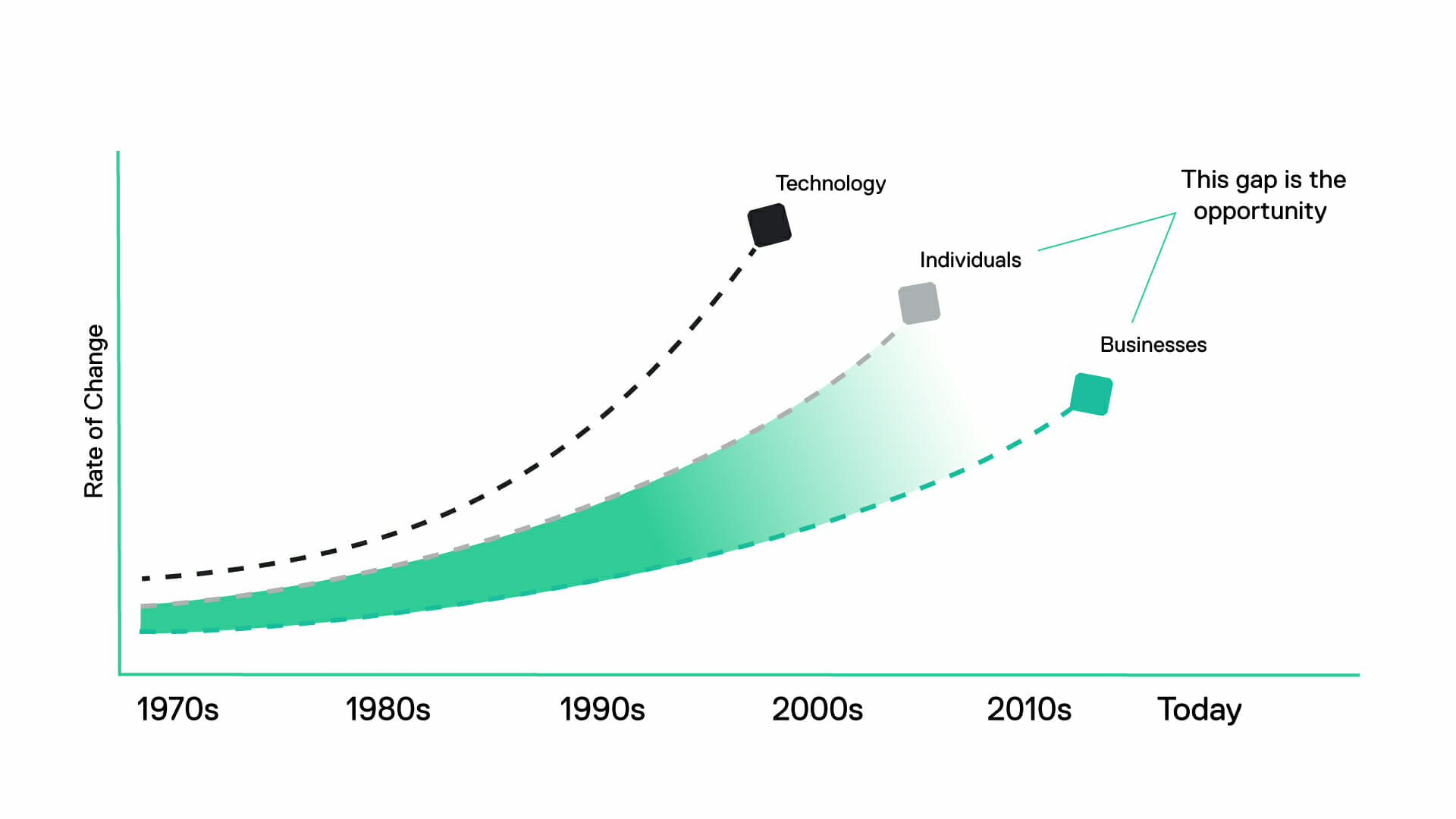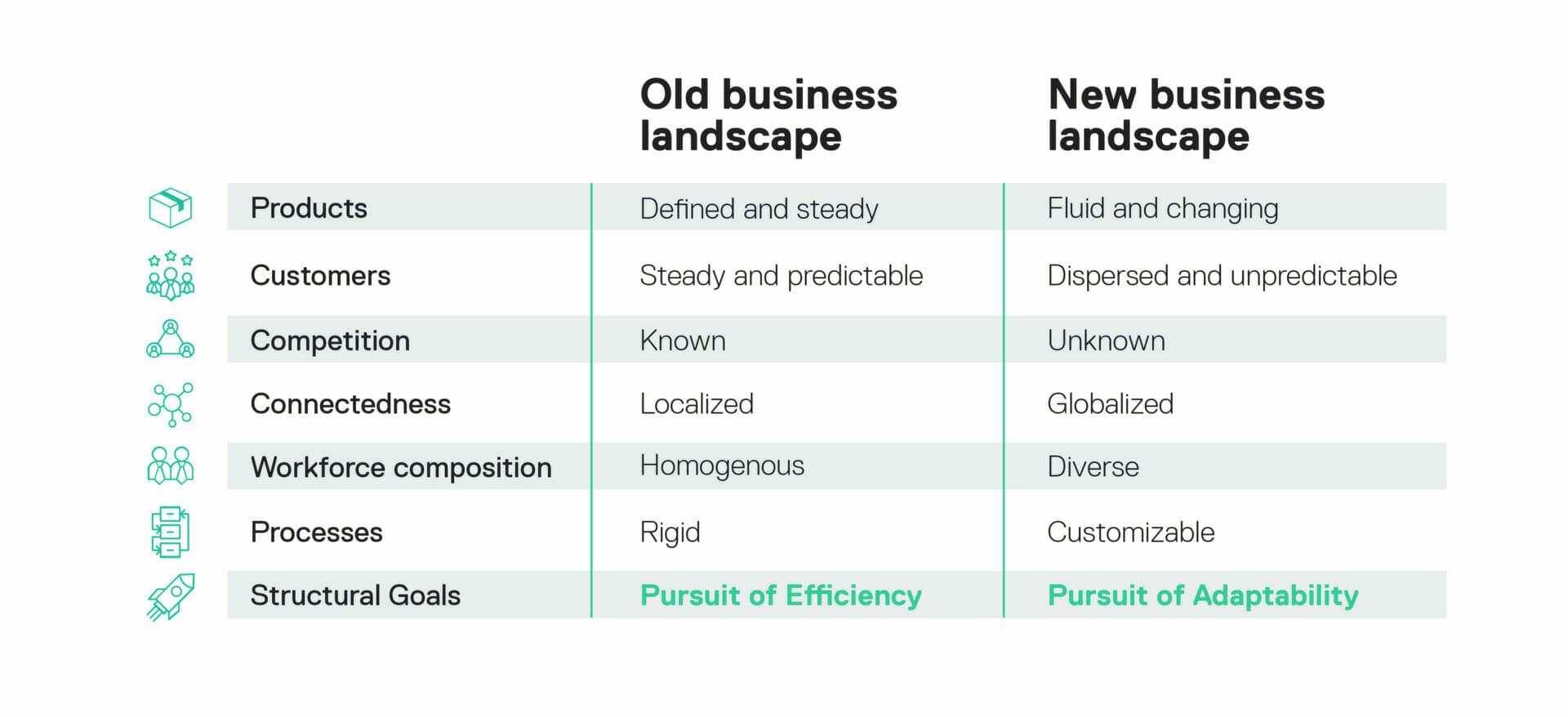Current vs. Future State of an Enterprise Set-Up
The modern business world is full of unpredictability. More and more frequently, pressing issues are solved with technological solutions. But with the rate of digital transformation increasing at an ever-quickening pace - requiring tech talent in more departments than ever before - how can companies best organize their future teams to ensure efficient and agile operations? Reimagining the team structures of future enterprise set-ups could be key.

Jump to section
Traditional business hierarchies
Disadvantages to the modern workforce
The old vs. new business landscape
How organizations are adapting
How your company can stay competitive
–
Reading this on your work device? If so, I wouldn’t want to bet on your location. Up until about three years ago, it would have been likely that while using a work laptop you’d probably be in your office. But with the recent rapid uptake of telecommuting, working from the kitchen table, a coffee shop, or even your own bed have become more likely than ever.
Although the technology that allows for remote working has been available for many years, unexpected lockdowns due to COVID-19 forced it to become mainstream. In this way, teleworking can be seen as an example of a technological solution to an unpredictable landscape.
The modern business world is abundant with technology and full of unpredictability. Unfortunately, not all solutions are as obvious as working remotely when employees are unable to physically commute. The need to harness technology in order to combat unforeseeable issues is becoming increasingly important for organizations to remain competitive. But how can this best be achieved? One way is through rethinking organizational structures.
Traditional business hierarchies
We all recognize the hierarchical structures which for many decades formed – and still form – typical business set-up. These hierarchies were detailed in Max Weber’s bureaucratic theory, which comprises of six factors:
-
Task specialization and labour split into simple routine categories.
-
Hierarchical authority
-
Formally selected employees
-
Rules and requirements based on market predictability
-
Impersonal decision free from emotion and personal factors
-
Career oriented where employees become experts in only their own field
Weber’s structure has formed the basis of successful business organization for decades. Even companies which have gradually leaned toward less rigid set-ups have still retained this hierarchical format. In the modern business landscape, however, organizational structures inspired by Weber’s theory are no longer primed for success.
Disadvantages to the modern workforce
As time has progressed, industrial revolutions have brought increased productivity to the workforce. Coal, gas, and electronics each offered employees further opportunity to scale output.
Productivity increased exponentially until around the turn of the millennium. The introduction of the internet and other digitization, also known as the fourth industrial revolution, still offers possibility for advantageous business progress, but has left workers feeling overwhelmed. Technology has accelerated at a rate where, although individuals are suited to keep pace, the businesses they work for are structured in a way which makes this impossible. This creates an opportunity gap.
 Source: Deloitte
Source: Deloitte
As the desire for digital transformation increases, companies need to reevaluate their rigid hierarchies to allow themselves the best chance of harnessing available technology. The organizations which most effectively narrow their opportunity gap will be in prime position to remain competitive in the new business landscape.
The old vs. new business landscape
This shift in accelerated digital transformation is a large contributor to the new business landscape, which compares to its predecessor as shown in the table below:
 Source: Deloitte
Source: Deloitte
Although digital transformation is crucial to modern business success, a mindset shift to pursue adaptability is fundamental to enterprise survival. The way organizations think and work needs to be developed away from the Weberian model in order to thrive in today’s “disrupt or be disrupted” world.
How organizations are adapting
Many businesses are seeking out ways to combat this new landscape by becoming more adaptive whilst narrowing their opportunity gap. Three potential methods of achieving this are detailed below:
1. Adapting team structures
It’s no secret that, in recent years, many companies have opted for flatter (or non-existent) hierarchies. In order to achieve this, teams have become less stratified and more like networks. Much-needed tech talent is distributed to traditionally non-tech departments, bucking the norm of conventional siloed, department-specific teams.
Collaborative groups, such as fusion teams, are being introduced to the workforce, allowing tech talent to fluidly work alongside other departments. These teams also possess the ability to produce and deploy products without needing the approval of management (and often bypassing standard tech governance), allowing companies to keep pace with competitors and new technological developments.
With Gartner reporting that 84% of companies already contain at least one fusion team, it’s clear to see how necessary these hierarchical shake-ups have become.
2. New behaviours and mindsets
The adoption of fusion teams, alongside other initiatives, brings new behaviours and mindsets to organizations. No longer requiring the approval of middle management, the fusion team process exhibits an organizational shift which encourages adaptability; the “fail-fast” mentality.
Often associated with lean start-up organizations, a fail-fast mentality emphasizes the importance of testing multiple processes with a view that if any fail, lessons can be learnt to further adapt the method until success is achieved. Failure takes on a different value than previously appreciated, which allows employees and teams more opportunity to trial much-needed “disruptive” processes.
Furthermore, in recent years, the mindsets of employees have shifted. Personnel no longer feel the need to work, as experienced by previous generations, but instead seek a desire to want to work, often for specific organizations. More frequently, employees look for roles which offer progression, autonomy, and learning.
As a result, companies are aware of the need to create work environments employees want to be in, not ones they feel they need to be in. To combat “the great resignation”, the need to provide adequate employee experience is growing.
3. Increased training
The need for adaptive processes comes with a need for an adaptive workforce. The most effective way to enable employees to adapt is to offer on-the-job training. Due to advancing technological progress, the choice of available roles will morph in the coming decades, creating an urgency in upskilling the workforce. A study by McKinsey revealed that more than 1 in 16 employees may need to switch occupations by 2030, with job growth more heavily concentrated in high skilled jobs. Middle and low-skilled roles will decline, in part due to processes such as automation.
Training instructors and teachers will likely also become more in demand, as well as further responsibilities taken on by HR Departments. It has been speculated that truly agile companies of the future will employ whole teams whose sole purpose will be to adaptively juggle employees, continually ensuring whole sections of the workforce are upskilled before being distributed to adapting tasks.
–
The above factors largely fly in the face of the traditional Weberian bureaucratic structure. Its hierarchies, rules, and specializations are simply too rigid for success in a fast paced technological environment. Agile, collaborative, and sometimes unorthodox methods are required to help organizations conquer the new business landscape.

How your company can stay competitive
As well as adapting in some of the ways listed above, Spryker products, such as Packaged Business Capabilities (PBCs), help companies remain agile in unpredictable times.
PBCs allow teams to tap into specific microservices and functionalities, offering the opportunity to rapidly test and scale key solutions. Their use of exposed APIs offer teams an opportunity to efficiently combine capabilities, benefiting a fail-fast mentality along with increased team autonomy.
Through their specific individual offerings and easy-to-utilize set-up, PBCs are an example of modular technology, which allows the picking and choosing of specific capabilities that suit your particular business needs. This stands in stark contrast to traditional monolithic structures which are less personal, less efficient, and ultimately lead companies towards less competitive agility. As seen throughout this post, the ability to disrupt and deploy new products at a rapid pace will prove crucial to organizational survival.
Keen to ensure your company can remain agile enough for the new business landscape? Learn more about Spryker’s PBCs from our sales team!